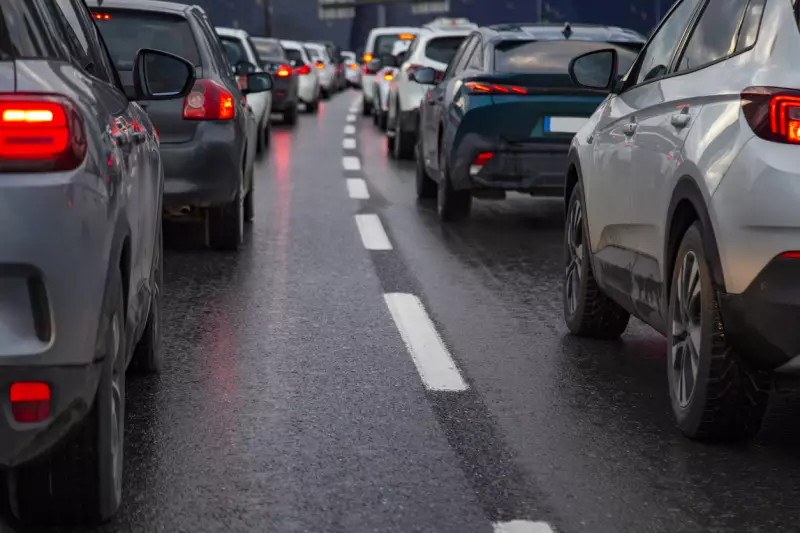Rear-end collisions can have devastating effects, leaving victims with serious injuries, long recovery times, and mounting medical bills, along with emotional trauma. Statistics reveal the gravity of the issue, with rear-end crashes responsible for nearly 30% of all injuries and a significant portion of property damage in vehicle accidents.
To prevent these tragedies, it is important for drivers to maintain a safe following distance. By allowing themselves more time to react, drivers can significantly reduce the likelihood of a crash, safeguarding themselves, their passengers, and others on the road. Following the 3 second rule driving is a simple yet effective method for achieving this.
What Is the 3-Second Rule in Driving?
The 3-second rule in driving is a safety principle that helps drivers promote safe vehicle spacing. The National Safety Council (NSC) advises passenger vehicle drivers to execute the minimum 3-second rule under ideal driving conditions.
How is your following distance determined? It is the time it takes your car to reach a fixed point after the vehicle in front of you has passed it, ideally three seconds. This gives you enough time to react and avoid a collision.
To correctly apply the 3-second rule:
- Choose a fixed point: Pick a stationary object ahead, like a sign or landmark.
- Observe the lead vehicle: When the rear of the vehicle in front passes your chosen point, start counting.
- Count to three: Count steadily: "one-thousand-one, one-thousand-two, one-thousand-three."
- Watch your speed: The faster you go, the more distance you need to stop. Increase the space between your vehicle and the one ahead.
The 3-second rule in driving is a guideline. However, always be ready to adjust the distance between vehicles depending on the current traffic and road conditions.
Why Three Seconds?
The 3-second rule in driving is rooted in a combination of average human reaction time and the physics of braking. A 2000 research indicates that the average driver needs between 1.33 to 1.5 seconds to perceive a hazard and then initiate a braking response. However, even during this reaction phase, the vehicle continues to move forward, which covers a significant distance.
This is where the three phases of stopping distance come in: perception, reaction, and braking. You first perceive the danger, then your brain reacts and signals your foot, and finally, the brakes engage to slow the car.
A chart from the NSC, used by defensive driving instructors, shows that stopping distances increase significantly with speed. At 55 mph, it takes nearly 346 feet to stop, while at 70 mph, the distance jumps to an alarming 490 feet.
This is why the 3-second rule in driving is so important—it allows enough stopping distance to account for both the driver's reaction time and the distance the vehicle travels while slowing down.
How to Apply the Three-Second Rule in Different Driving Conditions?

The 3-second rule in driving is not a one-size-fits-all guideline. It is a principle that necessitates adaptation to varying driving conditions, including normal conditions, adverse weather, and heavy traffic or urban settings.
Normal Driving Conditions
Under ideal circumstances, such as dry roads and clear visibility, the three-second rule functions as intended. When the vehicle ahead passes a stationary object, like a signpost or bridge, start counting.
If your vehicle reaches the same point before finishing the count, it is recommended to maintain a slightly greater following distance. This extra space acts as a safety cushion, giving you more time to react and brake smoothly if the vehicle ahead stops abruptly.
Adverse Weather Conditions
Studies indicate that 21% of vehicle crashes are weather-related. Prioritizing safety by adjusting your driving habits to the weather is essential in preventing accidents so that everyone reaches their destination safely.
Adverse weather conditions such as rain, snow, or fog significantly impact driving safety and necessitate adjustments to the 3-second rule in driving. Reduced visibility and slippery roads increase stopping distances, meaning the standard three-second rule may not provide enough time to avoid a collision.
Rain, for example, can reduce tire traction, which increases stopping distances by two to ten times. In wet weather, the National Highway Traffic Safety Administration recommended increasing the safe following distance to at least four seconds or more.
Winter weather, with snow and ice, demands even more caution. The American Meteorological Society indicated that nearly 1,000 fatalities occur annually on U.S. roadways due to winter weather alone.
Snow and fog can further impair visibility and traction, potentially requiring even more space. The American Auto Association advised doubling the car following distance, effectively applying a six-second rule.
Heavy Traffic and Urban Driving
Heavy traffic and urban driving present unique challenges.

The constant stop-and-go nature of these environments can make maintaining a consistent three-second gap difficult. However, it is important to prioritize safety over keeping up with the flow of traffic.
Increasing the safe following distance to a 4-second gap provides a greater buffer zone. This extra space allows for more reaction time in unpredictable situations.
Benefits of Following Other Vehicles at a Safe Distance
Rear-end collisions often result in the trailing driver being deemed at fault, which may result in traffic citations, legal complications, and higher insurance rates. Following other vehicles at a safe distance offers numerous benefits, most importantly reducing the risk of such crashes.
A safe following distance provides the driver with ample time to react and stop safely if the vehicle ahead brakes suddenly or encounters an unexpected hazard. It also allows for better visibility of the road ahead so drivers can anticipate potential problems and adjust their speed accordingly.
Consistently adhering to the three-second rule heightens situational driving awareness and sharpens reaction times. Drivers become attuned to the dynamics of traffic flow by instinctively responding to changing road conditions.
A clean driving record demonstrates responsible driving behavior. From a legal and financial standpoint, a safe following gap shields drivers from potential legal repercussions, possibly leading to lower insurance premiums.
Ultimately, the 3-second rule in driving is a beneficial practice for everyone. It promotes safety, reduces stress, and can even save you money.








![Best Sites to Check a Car’s History [2025 Review]](https://media.infopay.net/thumbnails/K8lMeG2QLjE46LPqZlmoi6SunKKdT5qvlaRZk6e1.webp)










![Best Sites to Check a Car’s History [2025 Review]](https://media.infopay.net/thumbnails/K8lMeG2QLjE46LPqZlmoi6SunKKdT5qvlaRZk6e1-w356.webp)
